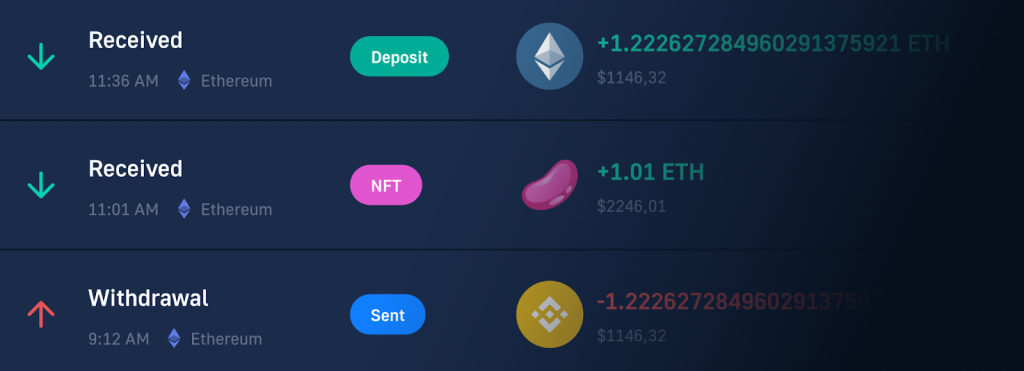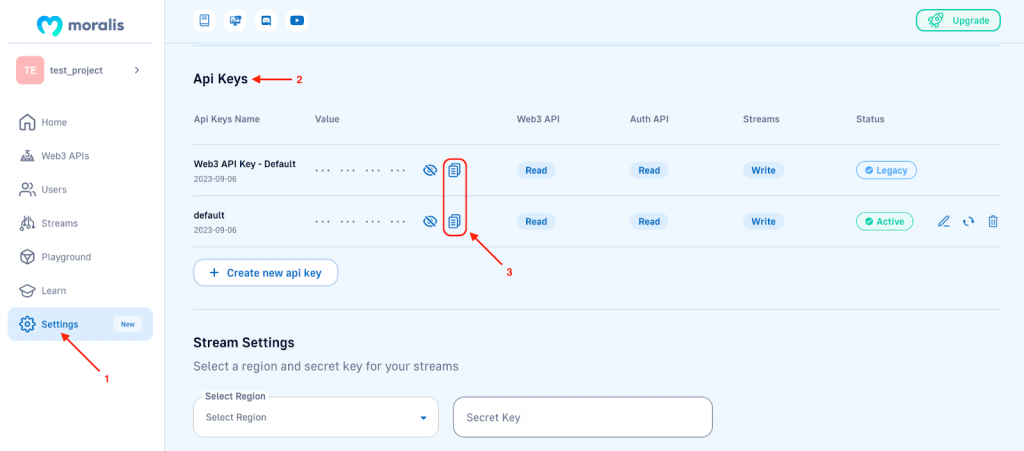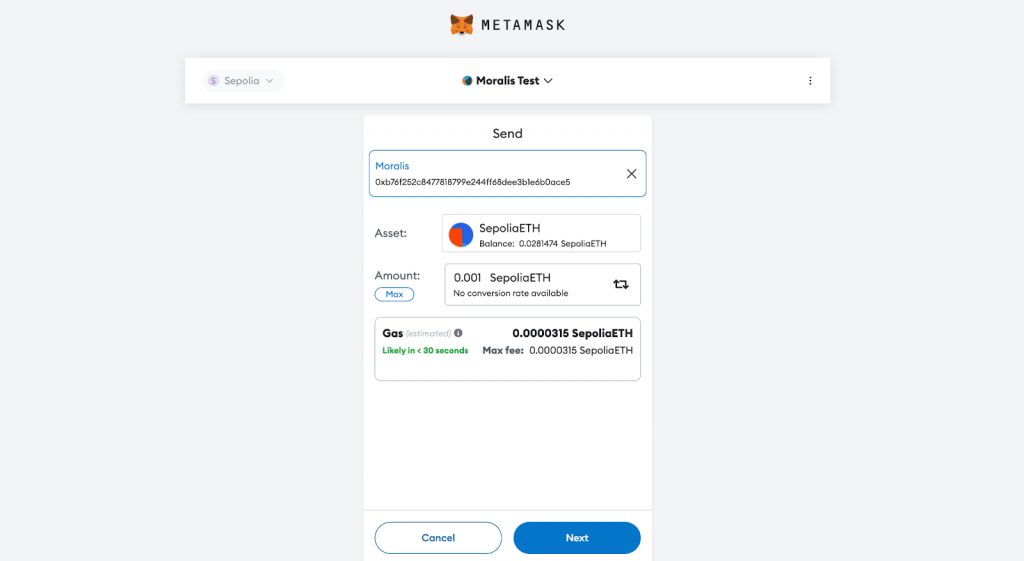[ad_1]

An actual-time pockets tracker is an utility or web site that means that you can monitor the exercise of Web3 wallets. Consequently, when constructing one, you want a streamlined technique for constantly observing pockets addresses and blockchain networks to detect occasions as quickly as they happen. And the best manner to take action is to leverage Moralis’ Streams API!
With this industry-leading growth device, you possibly can effortlessly arrange streams to get on the spot, customizable updates about occasions, sensible contracts, and wallets despatched on to your mission’s backend by way of webhooks. To focus on the facility of the Streams API, right here’s how simple it’s to arrange a stream that displays the native transactions of a pockets on the Sepolia testnet:
async perform streams(){
const choices = {
chains: [EvmChain.SEPOLIA],
tag: “transfers”,
description: “Take heed to Transfers”,
includeContractLogs: false,
includeNativeTxs: true,
webhookUrl: “replace_me”
}
const newStream = await Moralis.Streams.add(choices)
const {id} = newStream.toJSON();
const deal with = “replace_me”;
await Moralis.Streams.addAddress({deal with, id})
}
streams()
All it’s a must to do is initialize Moralis, add your webhook URL, and enter the deal with you want to monitor! Now, if you need a extra in-depth breakdown of how this works and how one can configure your streams additional, be part of us on this information or try the video beneath:
Additionally, with the intention to make calls to the Streams API, you want a Moralis account. As such, when you haven’t already, join with Moralis right away and get speedy entry to all our industry-leading Web3 growth instruments without spending a dime!
Overview
In as we speak’s article, we’ll kick issues off by exploring the intricacies of real-time pockets trackers. From there, we’ll introduce you to Moralis’ Streams API, as that is the best strategy to construct a real-time pockets tracker your self. Lastly, to high issues off, we’ll dive into our predominant tutorial and present you how you can monitor an deal with in real-time in 5 simple steps:
Get a Moralis API KeySet Up an Categorical ServerCreate a Moralis StreamRun the CodeTest Your Stream
So, when you’re already acquainted with the ins and outs of pockets trackers, be happy to skip straight into the ”Actual-Time Pockets Tracker Tutorial…” part and get proper into the motion!
Additionally, when you’re severe about constructing your personal real-time pockets tracker, take into account trying out some extra Moralis growth instruments. For instance, the Streams API works completely along with different interfaces, together with the Pockets API, NFT API, and Token API! So, when you haven’t already, don’t neglect to enroll with Moralis. You’ll be able to arrange your account without spending a dime and get speedy entry to all our industry-leading growth instruments, together with the Streams API!
What’s a Actual-Time Pockets Tracker?
An actual-time pockets tracker is a device that means that you can discover and monitor the exercise of a Web3 pockets. There are various choices accessible in the marketplace, they usually sometimes have their very own set of distinctive options. Some are fairly primary, solely offering easy transaction knowledge such because the switch quantity. In the meantime, others supply superior choices for personalisation and supply extra detailed info, together with block knowledge, logs, addresses, and so forth.

However how precisely does a real-time pockets tracker work?
The very best real-time pockets trackers normally permit customers to specify occasions of curiosity. This may be every part from native transactions to ERC-20 token transfers. As soon as a real-time pockets tracker is aware of what to search for, it constantly displays the related addresses for vital on-chain exercise. And as quickly because it detects an occasion, it instantly notifies the customers in order that they don’t miss a beat!
Nevertheless, monitoring addresses and blockchain networks with out correct instruments is a tedious activity, which is why the very best real-time pockets trackers leverage Web3 APIs to simplify the method of making the underlying infrastructure.
However what’s the finest real-time pockets tracker API? And how are you going to use instruments like these to construct decentralized purposes (dapps)?
Introducing Moralis’ Streams API – The Final Instrument for Constructing a Actual-Time Pockets Tracker
The best strategy to construct a real-time pockets tracker is to leverage Moralis’ Streams API. With this industry-leading device, you possibly can seamlessly arrange streams to obtain on the spot, customizable updates on to your mission’s backend by way of Moralis webhooks at any time when one thing vital occurs on-chain!

With the Streams API, you possibly can seamlessly monitor all kinds of occasions, NFTs, DeFi platforms, sensible contracts, wallets, and so forth. What’s extra, the interface helps 44 million contracts and counting throughout all main EVM blockchains, together with Ethereum, Polygon BNB Good Chain (BSC), and lots of others.
So, why must you be working with the Streams API?
With Moralis, it can save you each growth money and time. And to spotlight the facility of the Streams API, listed here are three outstanding advantages of this industry-leading device:
✅ Full Customization: The Streams API is the {industry}’s most versatile and customizable device for real-time blockchain knowledge. And with this API, you possibly can effortlessly arrange Web3 notifications for any use case you possibly can think about.
✅ Go To Market Quickly: Monitoring, indexing, and customizing real-time blockchain knowledge is an costly and time-consuming endeavor. Fortunately, with the Streams API, you possibly can monitor any deal with on any blockchain community with a couple of traces of code, permitting you to go to market sooner.
✅ Excessive Scalability: The Streams API is constructed to scale. For example, you possibly can seamlessly hearken to the 100 million most energetic Ethereum wallets with just one stream.

So, when working with Moralis and the Streams API, it has by no means been simpler to construct dapps integrating real-time updates and alerts! Nevertheless, to additional spotlight the accessibility of this device, be part of us within the subsequent part, as we’ll stroll you thru a complete real-time pockets tracker tutorial!
Actual-Time Pockets Tracker Tutorial: How you can Observe an Tackle in 5 Steps
One of many core functionalities of a real-time pockets tracker is the flexibility to observe a crypto deal with for related occasions. And since we received’t have the ability to cowl all pockets tracker options on this article, we’ll give attention to simply that. As such, on this tutorial, we’ll present you how you can seamlessly monitor the native transfers of a pockets in 5 steps utilizing the Streams API:
Get a Moralis API KeySet Up an Categorical ServerCreate a Moralis StreamRun the CodeTest Your Stream
Nevertheless, earlier than diving into the preliminary step of this real-time pockets tracker tutorial, you will need to cope with a couple of conditions!
Stipulations
Whereas the Streams API works with a number of programming languages, together with Python, JavaScript, and so forth., we’ll give attention to the latter on this tutorial. We will even use ngrok to arrange a webhook URL. As such, earlier than you possibly can proceed, it is advisable have the next prepared:
Node.js v.14+NPM/YarnNgrok
Step 1: Get a Moralis API Key
Calling Moralis’ Streams API requires an API key. As such, when you haven’t already, the very first thing it is advisable do is click on on the ”Begin for Free” button on the high proper to enroll with Moralis:

From there, go to the ”Settings” tab, find the ”API Keys” part, and replica your Moralis API key:

Save the important thing for now, as you’ll want it when initializing Moralis within the third step!
Step 2: Set Up an Categorical Server
For the second step, it is advisable arrange a easy server to obtain the Web3 webooks from Moralis. To take action, we’ll be utilizing the Categorical Node.js utility framework!
As such, to begin issues off, arrange a brand new mission in your built-in growth atmosphere (IDE). From there, open a brand new terminal, cd into the mission’s root folder, and set up Categorical with the next command:
npm set up categorical
Subsequent, create a brand new ”index.js” file and add the next code:
const categorical = require(“categorical”);
const app = categorical();
const port = 3000;
app.use(categorical.json());
app.submit(“/webhook”, async (req, res) => {
const {physique} = req;
attempt {
console.log(physique);
} catch (e) {
console.log(e);
return res.standing(400).json();
}
return res.standing(200).json();
});
app.pay attention(port, () => {
console.log(`Listening to streams`);
});
The code defines a single /webhook path to which Moralis can submit your streams. Right here, we parse the physique of the response and log it within the console:
app.submit(“/webhook”, async (req, res) => {
const {physique} = req;
attempt {
console.log(physique);
} catch (e) {
console.log(e);
return res.standing(400).json();
}
return res.standing(200).json();
});
From right here, now you can begin the Categorical server by opening a brand new terminal and operating the next command:
node index.js
With the server up and operating, you will need to open a brand new tunnel to ”port 3000” utilizing ngrok. To take action, launch a brand new terminal and run this command:
ngrok http http://localhost:3000
Working the command above will open a window just like the one beneath the place it is advisable copy and save your webhook URL:

Step 3: Create a Moralis Stream
Now that your server is up and operating, it’s time to create your stream utilizing Moralis’ Streams API. As such, arrange a brand new Node.js mission in your IDE and create a ”.env” file in its root folder. This file will host a MORALIS_KEY atmosphere variable, and it ought to look one thing like this:
MORALIS_KEY=’YOUR_API_KEY’
Merely exchange YOUR_API_KEY with the important thing you copied throughout step one of this tutorial.
Subsequent, arrange a brand new ”index.js” file and add the code beneath:
const Moralis = require(“moralis”).default;
const { EvmChain } = require(“@moralisweb3/common-evm-utils”);
require(“dotenv”).config();
Moralis.begin({
apiKey: course of.env.MORALIS_KEY,
});
async perform streams(){
const choices = {
chains: [EvmChain.SEPOLIA],
tag: “transfers”,
description: “Take heed to Transfers”,
includeContractLogs: false,
includeNativeTxs: true,
webhookUrl: “replace_me”
}
const newStream = await Moralis.Streams.add(choices)
const {id} = newStream.toJSON();
const deal with = “0xa50981073aB67555c14F4640CEeB5D3efC5c7af2”;
await Moralis.Streams.addAddress({deal with, id})
console.log(“Stream efficiently created”)
}
streams()
So, what precisely is occurring right here?
To clarify, we’ll break down a couple of important elements of the code beneath!
On the high of the ”index.js” file, we begin by importing Moralis and the atmosphere variable from the ”.env” file:
const Moralis = require(“moralis”).default;
const { EvmChain } = require(“@moralisweb3/common-evm-utils”);
require(“dotenv”).config();
Subsequent, we use our API key to initialize the Moralis SDK:
Moralis.begin({
apiKey: course of.env.MORALIS_KEY,
});
We then create a brand new streams() perform the place we arrange an choices object:
async perform streams(){
const choices = {
chains: [EvmChain.SEPOLIA],
tag: “transfers”,
description: “Take heed to Transfers”,
includeContractLogs: false,
includeNativeTxs: true,
webhookUrl: “replace_me”
}
//…
}
The choices object is used to configure our stream, and it has a number of parameters, together with chains, tag, description, webhookUrl, and so forth. That is additionally the place we specify the occasions we wish our stream to observe.
On this case, we configured our stream to observe the Sepolia testnet for native transactions. If you wish to monitor one other chain for different occasions, merely configure the parameters of choices.
Additionally, don’t neglect so as to add your webhook URL by changing replace_me and appending /webhook on the finish. All in all, the webhookUrl parameter of the choices object ought to look one thing like this:
webhookUrl: “https://1192-80-217-157-107.ngrok-free.app/webhook”
We then create a brand new stream by calling Moralis’ Stream.add() technique utilizing choices:
const newStream = await Moralis.Streams.add(choices)
Subsequent, we get the id from the brand new stream and create an deal with const to which we add the deal with we need to monitor:
const {id} = newStream.toJSON();
const deal with = “0xa50981073aB67555c14F4640CEeB5D3efC5c7af2”;
Lastly, we use id and deal with so as to add the deal with to our stream:
await Moralis.Streams.addAddress({deal with, id})
Step 4: Run the Code
For the ultimate step, you will need to execute the code above by operating the script. Nevertheless, it is advisable set up a few dependencies earlier than doing so. As such, open a brand new terminal and run the next command:
npm set up moralis @moralisweb3/common-evm-utils dotenv
Subsequent, run this command within the mission’s root folder to execute the script:
node index.js
If every part labored as supposed, your server ought to now have acquired an empty webhook response wanting one thing like this:
{
abi: [],
block: { quantity: ”, hash: ”, timestamp: ” },
txs: [],
txsInternal: [],
logs: [],
chainId: ”,
confirmed: true,
retries: 0,
tag: ”,
streamId: ”,
erc20Approvals: [],
erc20Transfers: [],
nftTokenApprovals: [],
nftApprovals: { ERC721: [], ERC1155: [] },
nftTransfers: [],
nativeBalances: []
}
And that’s it; you’ve got efficiently created a stream monitoring the native Sepolia testnet transactions of the required deal with!
Within the subsequent part, we’ll briefly present you how you can check that every part works because it ought to!
Step 5: Check Your Stream
With the Moralis stream energetic, your server ought to now begin to obtain webhook responses at any time when the deal with in query sends a local transaction on the Sepolia testnet. In our case, we added considered one of our MetaMask pockets addresses to the stream. As such, to check that every part is working as supposed, we’ll merely ship a small quantity of Sepolia testnet ETH to a different deal with:

As quickly because the transaction is finalized, your server ought to have acquired a response wanting one thing like this:
{
confirmed: true,
chainId: ‘0xaa36a7’,
abi: [],
streamId: ‘a6c08210-c7dc-416c-a140-4746478530ce’,
tag: ‘transfers’,
retries: 0,
block: {
quantity: ‘4692430’,
hash: ‘0x31754432aa984e524472abb52c05f3175471ae2cb209a751f31e75a9dfab6a94’,
timestamp: ‘1699967412’
},
logs: [],
txs: [
{
hash: ‘0x2fc3678670ee9895dc5dfc5f189f9839ab5c7351905b6d2b419518a5334450a2’,
gas: ‘21000’,
gasPrice: ‘1639464455’,
nonce: ‘9’,
input: ‘0x’,
transactionIndex: ’78’,
fromAddress: ‘0xa50981073ab67555c14f4640ceeb5d3efc5c7af2’,
toAddress: ‘0xb76f252c8477818799e244ff68dee3b1e6b0ace5’,
value: ‘100000000000000’,
type: ‘2’,
//…
receiptCumulativeGasUsed: ‘25084154’,
receiptGasUsed: ‘21000’,
receiptContractAddress: null,
receiptRoot: null,
receiptStatus: ‘1’
}
],
//…
}
The response accommodates a bunch of knowledge, together with block knowledge, a transaction hash, addresses, the transaction quantity, and rather more. And now you can leverage this info to construct a complete real-time pockets tracker very quickly!
For those who’d prefer to be taught extra about how this device works and how one can configure your streams in numerous methods, try our Streams API documentation web page!
Abstract: How you can Construct a Actual-Time Pockets Tracker
In as we speak’s article, we confirmed you how you can monitor an deal with in real-time utilizing Moralis’ Streams API. And because of the accessibility of this device, we have been ready to take action in 5 simple steps:
Get a Moralis API KeySet Up an Categorical ServerCreate a Moralis StreamRun the CodeTest Your Stream
As such, when you’ve got adopted alongside this far, you now know how you can arrange your personal streams to observe wallets on a number of blockchain networks with the Streams API. From right here, now you can use your newly acquired expertise to construct your personal on-chain pockets tracker!

For those who preferred this crypto pockets monitoring tutorial, take into account trying out extra content material right here on Moralis’ weblog. For example, learn in regards to the high block explorer API or learn to construct on Solana and EVM. Additionally, don’t neglect to enroll with Moralis if you wish to leverage our industry-leading Web3 APIs your self!
[ad_2]
Source link
